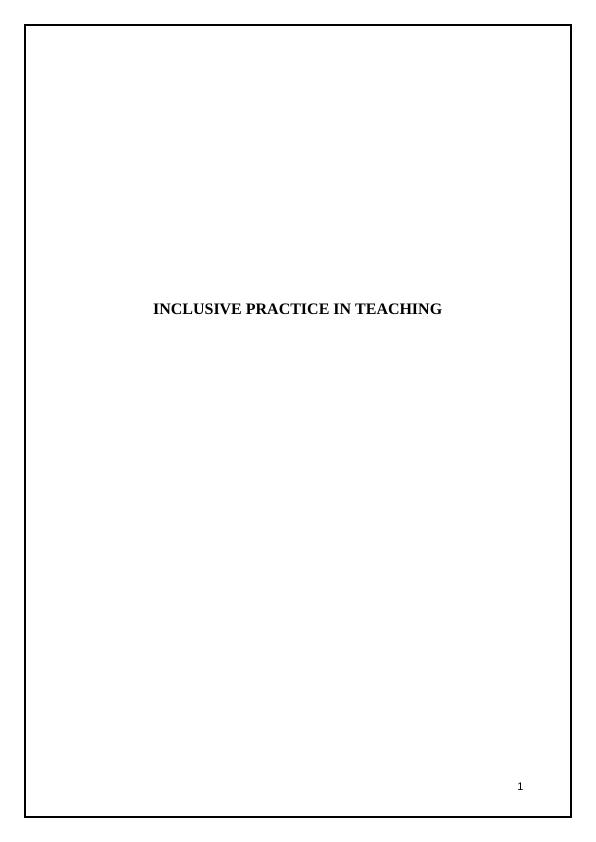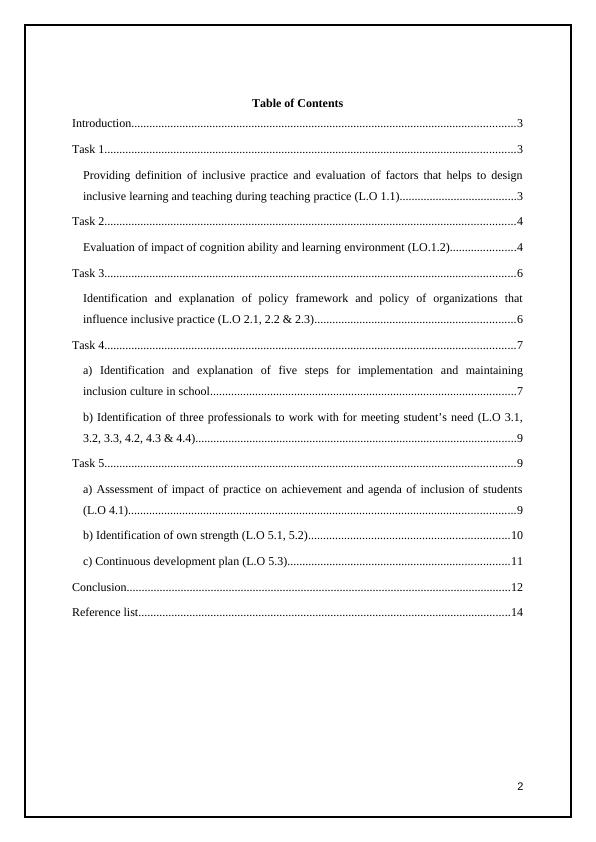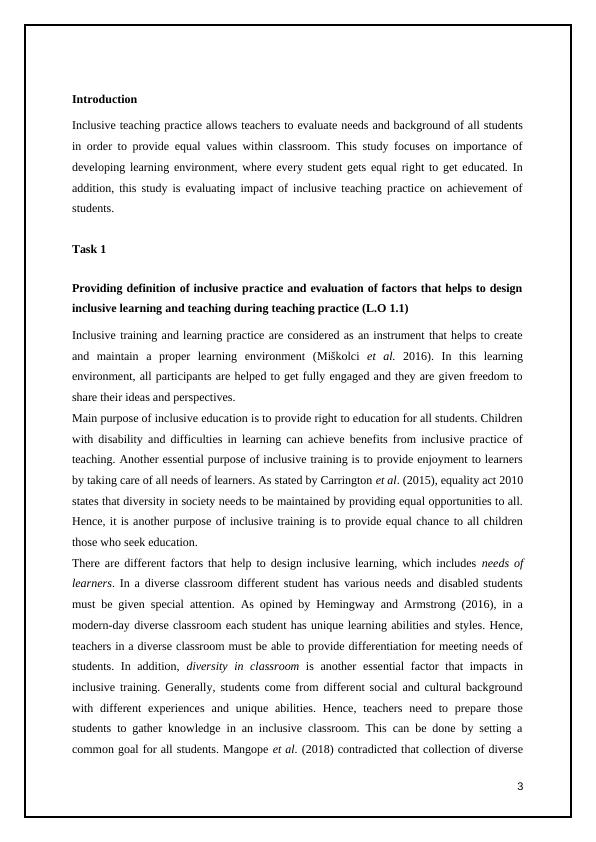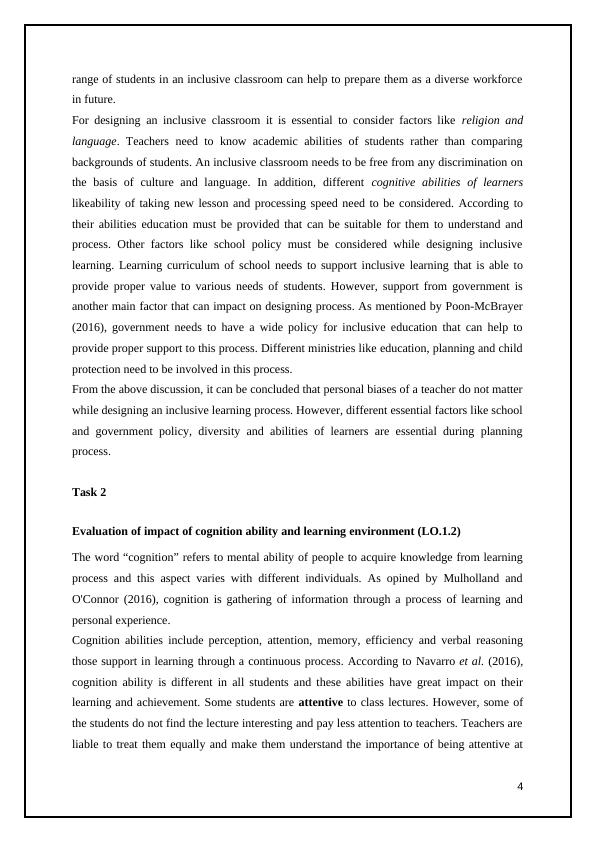Inclusive Practice in Teaching
Added on 2023-01-19
16 Pages4560 Words1 Views
INCLUSIVE PRACTICE IN TEACHING
1
1

Table of Contents
Introduction................................................................................................................................3
Task 1.........................................................................................................................................3
Providing definition of inclusive practice and evaluation of factors that helps to design
inclusive learning and teaching during teaching practice (L.O 1.1).......................................3
Task 2.........................................................................................................................................4
Evaluation of impact of cognition ability and learning environment (LO.1.2)......................4
Task 3.........................................................................................................................................6
Identification and explanation of policy framework and policy of organizations that
influence inclusive practice (L.O 2.1, 2.2 & 2.3)...................................................................6
Task 4.........................................................................................................................................7
a) Identification and explanation of five steps for implementation and maintaining
inclusion culture in school......................................................................................................7
b) Identification of three professionals to work with for meeting student’s need (L.O 3.1,
3.2, 3.3, 4.2, 4.3 & 4.4)...........................................................................................................9
Task 5.........................................................................................................................................9
a) Assessment of impact of practice on achievement and agenda of inclusion of students
(L.O 4.1).................................................................................................................................9
b) Identification of own strength (L.O 5.1, 5.2)...................................................................10
c) Continuous development plan (L.O 5.3)..........................................................................11
Conclusion................................................................................................................................12
Reference list............................................................................................................................14
2
Introduction................................................................................................................................3
Task 1.........................................................................................................................................3
Providing definition of inclusive practice and evaluation of factors that helps to design
inclusive learning and teaching during teaching practice (L.O 1.1).......................................3
Task 2.........................................................................................................................................4
Evaluation of impact of cognition ability and learning environment (LO.1.2)......................4
Task 3.........................................................................................................................................6
Identification and explanation of policy framework and policy of organizations that
influence inclusive practice (L.O 2.1, 2.2 & 2.3)...................................................................6
Task 4.........................................................................................................................................7
a) Identification and explanation of five steps for implementation and maintaining
inclusion culture in school......................................................................................................7
b) Identification of three professionals to work with for meeting student’s need (L.O 3.1,
3.2, 3.3, 4.2, 4.3 & 4.4)...........................................................................................................9
Task 5.........................................................................................................................................9
a) Assessment of impact of practice on achievement and agenda of inclusion of students
(L.O 4.1).................................................................................................................................9
b) Identification of own strength (L.O 5.1, 5.2)...................................................................10
c) Continuous development plan (L.O 5.3)..........................................................................11
Conclusion................................................................................................................................12
Reference list............................................................................................................................14
2

Introduction
Inclusive teaching practice allows teachers to evaluate needs and background of all students
in order to provide equal values within classroom. This study focuses on importance of
developing learning environment, where every student gets equal right to get educated. In
addition, this study is evaluating impact of inclusive teaching practice on achievement of
students.
Task 1
Providing definition of inclusive practice and evaluation of factors that helps to design
inclusive learning and teaching during teaching practice (L.O 1.1)
Inclusive training and learning practice are considered as an instrument that helps to create
and maintain a proper learning environment (Miškolci et al. 2016). In this learning
environment, all participants are helped to get fully engaged and they are given freedom to
share their ideas and perspectives.
Main purpose of inclusive education is to provide right to education for all students. Children
with disability and difficulties in learning can achieve benefits from inclusive practice of
teaching. Another essential purpose of inclusive training is to provide enjoyment to learners
by taking care of all needs of learners. As stated by Carrington et al. (2015), equality act 2010
states that diversity in society needs to be maintained by providing equal opportunities to all.
Hence, it is another purpose of inclusive training is to provide equal chance to all children
those who seek education.
There are different factors that help to design inclusive learning, which includes needs of
learners. In a diverse classroom different student has various needs and disabled students
must be given special attention. As opined by Hemingway and Armstrong (2016), in a
modern-day diverse classroom each student has unique learning abilities and styles. Hence,
teachers in a diverse classroom must be able to provide differentiation for meeting needs of
students. In addition, diversity in classroom is another essential factor that impacts in
inclusive training. Generally, students come from different social and cultural background
with different experiences and unique abilities. Hence, teachers need to prepare those
students to gather knowledge in an inclusive classroom. This can be done by setting a
common goal for all students. Mangope et al. (2018) contradicted that collection of diverse
3
Inclusive teaching practice allows teachers to evaluate needs and background of all students
in order to provide equal values within classroom. This study focuses on importance of
developing learning environment, where every student gets equal right to get educated. In
addition, this study is evaluating impact of inclusive teaching practice on achievement of
students.
Task 1
Providing definition of inclusive practice and evaluation of factors that helps to design
inclusive learning and teaching during teaching practice (L.O 1.1)
Inclusive training and learning practice are considered as an instrument that helps to create
and maintain a proper learning environment (Miškolci et al. 2016). In this learning
environment, all participants are helped to get fully engaged and they are given freedom to
share their ideas and perspectives.
Main purpose of inclusive education is to provide right to education for all students. Children
with disability and difficulties in learning can achieve benefits from inclusive practice of
teaching. Another essential purpose of inclusive training is to provide enjoyment to learners
by taking care of all needs of learners. As stated by Carrington et al. (2015), equality act 2010
states that diversity in society needs to be maintained by providing equal opportunities to all.
Hence, it is another purpose of inclusive training is to provide equal chance to all children
those who seek education.
There are different factors that help to design inclusive learning, which includes needs of
learners. In a diverse classroom different student has various needs and disabled students
must be given special attention. As opined by Hemingway and Armstrong (2016), in a
modern-day diverse classroom each student has unique learning abilities and styles. Hence,
teachers in a diverse classroom must be able to provide differentiation for meeting needs of
students. In addition, diversity in classroom is another essential factor that impacts in
inclusive training. Generally, students come from different social and cultural background
with different experiences and unique abilities. Hence, teachers need to prepare those
students to gather knowledge in an inclusive classroom. This can be done by setting a
common goal for all students. Mangope et al. (2018) contradicted that collection of diverse
3

range of students in an inclusive classroom can help to prepare them as a diverse workforce
in future.
For designing an inclusive classroom it is essential to consider factors like religion and
language. Teachers need to know academic abilities of students rather than comparing
backgrounds of students. An inclusive classroom needs to be free from any discrimination on
the basis of culture and language. In addition, different cognitive abilities of learners
likeability of taking new lesson and processing speed need to be considered. According to
their abilities education must be provided that can be suitable for them to understand and
process. Other factors like school policy must be considered while designing inclusive
learning. Learning curriculum of school needs to support inclusive learning that is able to
provide proper value to various needs of students. However, support from government is
another main factor that can impact on designing process. As mentioned by Poon-McBrayer
(2016), government needs to have a wide policy for inclusive education that can help to
provide proper support to this process. Different ministries like education, planning and child
protection need to be involved in this process.
From the above discussion, it can be concluded that personal biases of a teacher do not matter
while designing an inclusive learning process. However, different essential factors like school
and government policy, diversity and abilities of learners are essential during planning
process.
Task 2
Evaluation of impact of cognition ability and learning environment (LO.1.2)
The word “cognition” refers to mental ability of people to acquire knowledge from learning
process and this aspect varies with different individuals. As opined by Mulholland and
O'Connor (2016), cognition is gathering of information through a process of learning and
personal experience.
Cognition abilities include perception, attention, memory, efficiency and verbal reasoning
those support in learning through a continuous process. According to Navarro et al. (2016),
cognition ability is different in all students and these abilities have great impact on their
learning and achievement. Some students are attentive to class lectures. However, some of
the students do not find the lecture interesting and pay less attention to teachers. Teachers are
liable to treat them equally and make them understand the importance of being attentive at
4
in future.
For designing an inclusive classroom it is essential to consider factors like religion and
language. Teachers need to know academic abilities of students rather than comparing
backgrounds of students. An inclusive classroom needs to be free from any discrimination on
the basis of culture and language. In addition, different cognitive abilities of learners
likeability of taking new lesson and processing speed need to be considered. According to
their abilities education must be provided that can be suitable for them to understand and
process. Other factors like school policy must be considered while designing inclusive
learning. Learning curriculum of school needs to support inclusive learning that is able to
provide proper value to various needs of students. However, support from government is
another main factor that can impact on designing process. As mentioned by Poon-McBrayer
(2016), government needs to have a wide policy for inclusive education that can help to
provide proper support to this process. Different ministries like education, planning and child
protection need to be involved in this process.
From the above discussion, it can be concluded that personal biases of a teacher do not matter
while designing an inclusive learning process. However, different essential factors like school
and government policy, diversity and abilities of learners are essential during planning
process.
Task 2
Evaluation of impact of cognition ability and learning environment (LO.1.2)
The word “cognition” refers to mental ability of people to acquire knowledge from learning
process and this aspect varies with different individuals. As opined by Mulholland and
O'Connor (2016), cognition is gathering of information through a process of learning and
personal experience.
Cognition abilities include perception, attention, memory, efficiency and verbal reasoning
those support in learning through a continuous process. According to Navarro et al. (2016),
cognition ability is different in all students and these abilities have great impact on their
learning and achievement. Some students are attentive to class lectures. However, some of
the students do not find the lecture interesting and pay less attention to teachers. Teachers are
liable to treat them equally and make them understand the importance of being attentive at
4

End of preview
Want to access all the pages? Upload your documents or become a member.
Related Documents
Inclusive Teaching Practice: Roles, Referral Points, and Strategies for Improvementlg...
|8
|2042
|232
The Practice of Inclusive Learning, Teaching and Assessmentlg...
|8
|3071
|159
Teaching, Learning and Assessment in Education and Traininglg...
|22
|8001
|18
Developing Teaching, Learning and Assessment in Education and Traininglg...
|8
|2024
|74
Inclusive Practice in Education and Training Sectorlg...
|19
|6475
|55
Inclusive Practicelg...
|20
|6785
|2
